TOYOTA AYGO 2017 (in English) Service Manual
Manufacturer: TOYOTA, Model Year: 2017, Model line: AYGO, Model: TOYOTA AYGO 2017Pages: 480, PDF Size: 40.72 MB
Page 41 of 480
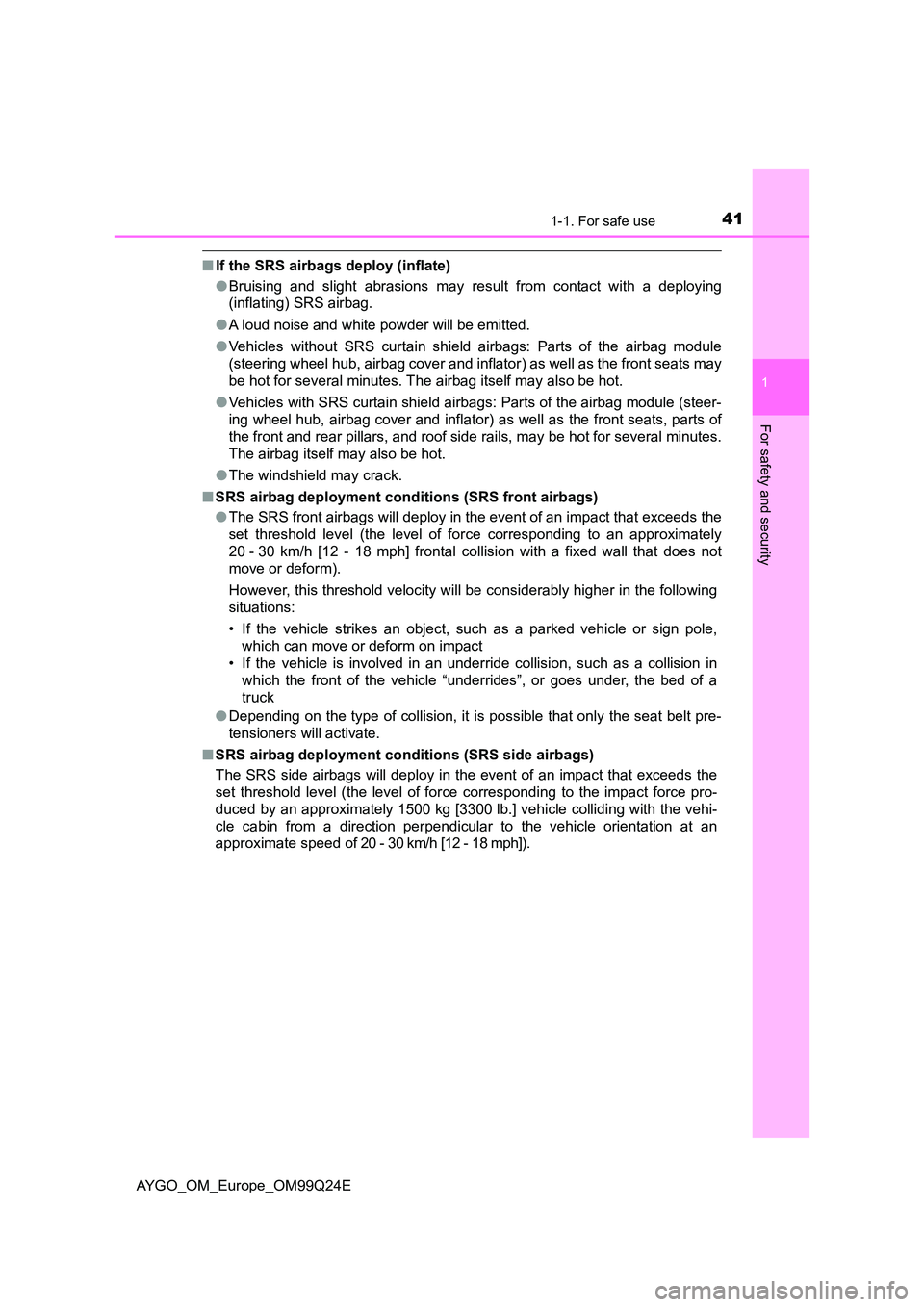
411-1. For safe use
1
For safety and security
AYGO_OM_Europe_OM99Q24E
■If the SRS airbags deploy (inflate)
● Bruising and slight abrasions may result from contact with a deploying
(inflating) SRS airbag.
● A loud noise and white powder will be emitted.
● Vehicles without SRS curtain shield airbags: Parts of the airbag module
(steering wheel hub, airbag cover and inflator) as well as the front seats may
be hot for several minutes. The airbag itself may also be hot.
● Vehicles with SRS curtain shield airbags: Parts of the airbag module (steer-
ing wheel hub, airbag cover and inflator) as well as the front seats, parts of
the front and rear pillars, and roof side rails, may be hot for several minutes.
The airbag itself may also be hot.
● The windshield may crack.
■ SRS airbag deployment conditions (SRS front airbags)
● The SRS front airbags will deploy in the event of an impact that exceeds the
set threshold level (the level of force corresponding to an approximately
20 - 30 km/h [12 - 18 mph] frontal collision with a fixed wall that does not
move or deform).
However, this threshold velocity will be considerably higher in the following
situations:
• If the vehicle strikes an object, such as a parked vehicle or sign pole,
which can move or deform on impact
• If the vehicle is involved in an underride collision, such as a collision in
which the front of the vehicle “underrides”, or goes under, the bed of a
truck
● Depending on the type of collision, it is possible that only the seat belt pre-
tensioners will activate.
■ SRS airbag deployment conditions (SRS side airbags)
The SRS side airbags will deploy in the event of an impact that exceeds the
set threshold level (the level of force corresponding to the impact force pro-
duced by an approximately 1500 kg [3300 lb.] vehicle colliding with the vehi-
cle cabin from a direction perpendicula r to the vehicle orientation at an
approximate speed of 20 - 30 km/h [12 - 18 mph]).
Page 42 of 480
![TOYOTA AYGO 2017 (in English) Service Manual 421-1. For safe use
AYGO_OM_Europe_OM99Q24E
■ SRS airbag deployment conditions (SRS side and curtain shield airbags
[if equipped])
● The SRS side and curtain shield airbags will deploy in the e TOYOTA AYGO 2017 (in English) Service Manual 421-1. For safe use
AYGO_OM_Europe_OM99Q24E
■ SRS airbag deployment conditions (SRS side and curtain shield airbags
[if equipped])
● The SRS side and curtain shield airbags will deploy in the e](/img/14/48432/w960_48432-41.png)
421-1. For safe use
AYGO_OM_Europe_OM99Q24E
■ SRS airbag deployment conditions (SRS side and curtain shield airbags
[if equipped])
● The SRS side and curtain shield airbags will deploy in the event of an
impact that exceeds the set threshold level (the level of force corresponding
to the impact force produced by an approximately 1500 kg [3300 lb.] vehicle
colliding with the vehicle cabin from a direction perpendicular to the vehicle
orientation at an approximate speed of 20 - 30 km/h [12 - 18 mph]).
● The SRS curtain shield airbags may also deploy in the event of a severe
frontal collision.
■ Conditions under which the SRS airbags may deploy (inflate), other than
a collision
The SRS front airbags and SRS curtain shield airbags (if equipped) may also
deploy if a serious impact occurs to the underside of your vehicle. Some
examples are shown in the illustration.
■ Types of collisions that may not deploy the SRS airbags (SRS front
airbags)
The SRS front airbags do not generally infl ate if the vehicle is involved in a
side or rear collision, if it rolls over, or if it is involved in a low-speed frontal
collision. But, whenever a collision of any type causes sufficient forward
deceleration of the vehicle, deployment of the SRS front airbags may occur.
● Hitting a curb, edge of pavement or hard
surface
● Falling into or jumping over a deep hole
● Landing hard or falling
● Collision from the side
● Collision from the rear
● Vehicle rollover
Page 43 of 480
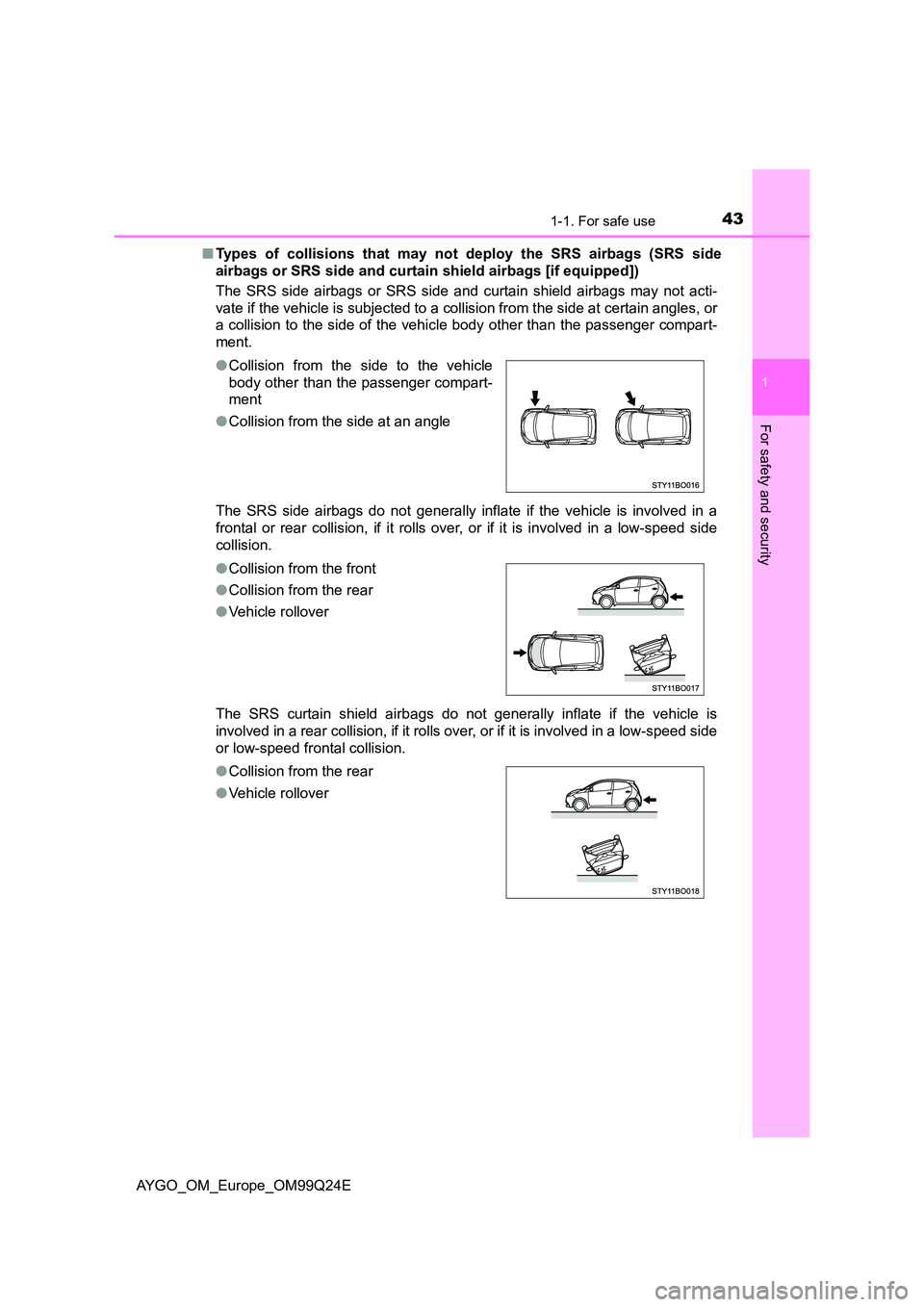
431-1. For safe use
1
For safety and security
AYGO_OM_Europe_OM99Q24E
■ Types of collisions that may not deploy the SRS airbags (SRS side
airbags or SRS side and curtai n shield airbags [if equipped])
The SRS side airbags or SRS side and curtain shield airbags may not acti-
vate if the vehicle is subjected to a collision from the side at certain angles, or
a collision to the side of the vehicle body other than the passenger compart-
ment.
The SRS side airbags do not generally inflate if the vehicle is involved in a
frontal or rear collision, if it rolls ov er, or if it is involved in a low-speed side
collision.
The SRS curtain shield airbags do not generally inflate if the vehicle is
involved in a rear collision, if it rolls over, or if it is involved in a low-speed side
or low-speed frontal collision.
● Collision from the side to the vehicle
body other than the passenger compart-
ment
● Collision from the side at an angle
● Collision from the front
● Collision from the rear
● Vehicle rollover
● Collision from the rear
● Vehicle rollover
Page 44 of 480
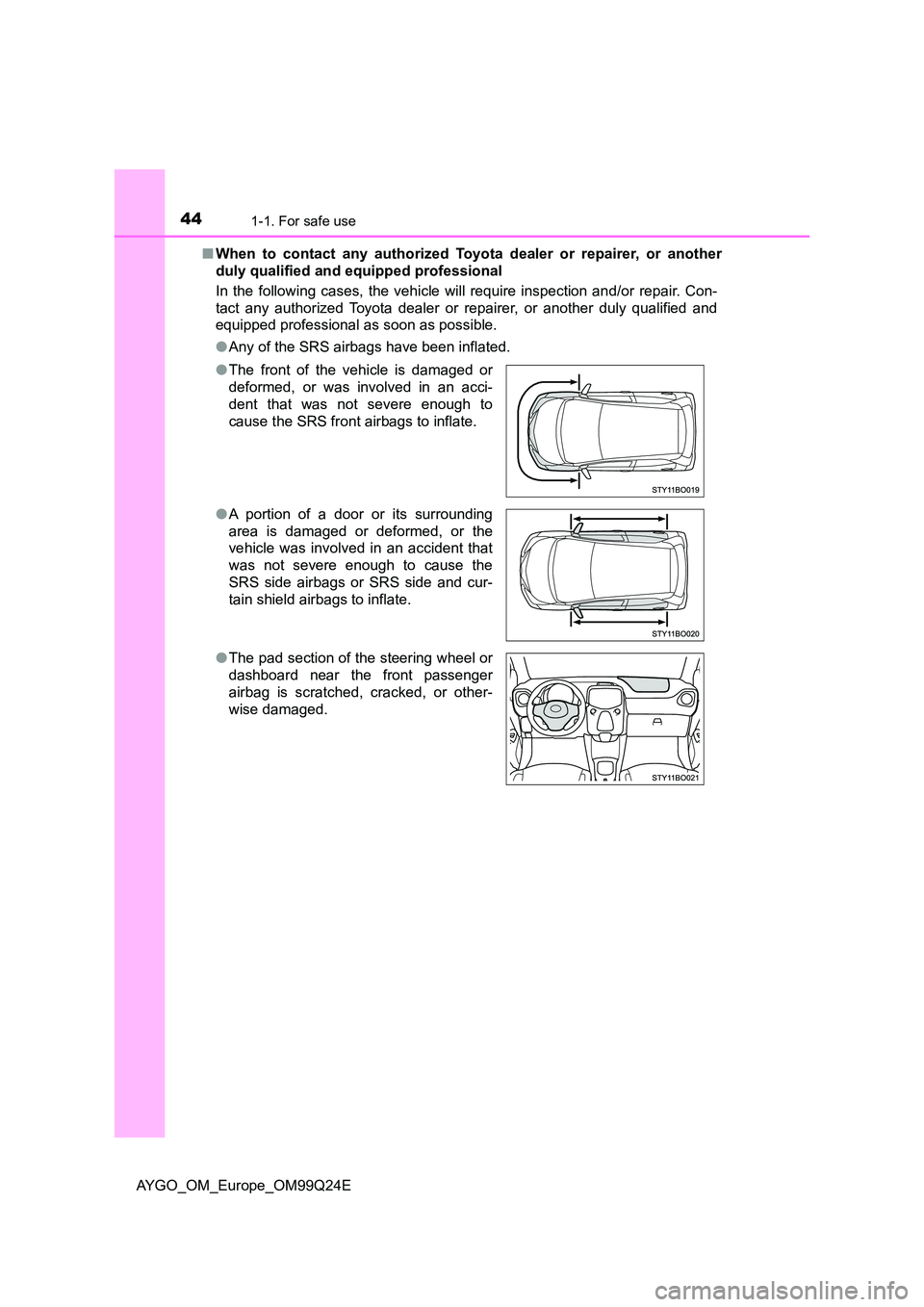
441-1. For safe use
AYGO_OM_Europe_OM99Q24E
■ When to contact any authorized Toyota dealer or repairer, or another
duly qualified and equipped professional
In the following cases, the vehicle will require inspection and/or repair. Con-
tact any authorized Toyota dealer or repairer, or another duly qualified and
equipped professional as soon as possible.
● Any of the SRS airbags have been inflated.
● The front of the vehicle is damaged or
deformed, or was involved in an acci-
dent that was not severe enough to
cause the SRS front airbags to inflate.
● A portion of a door or its surrounding
area is damaged or deformed, or the
vehicle was involved in an accident that
was not severe enough to cause the
SRS side airbags or SRS side and cur-
tain shield airbags to inflate.
● The pad section of the steering wheel or
dashboard near the front passenger
airbag is scratched, cracked, or other-
wise damaged.
Page 45 of 480
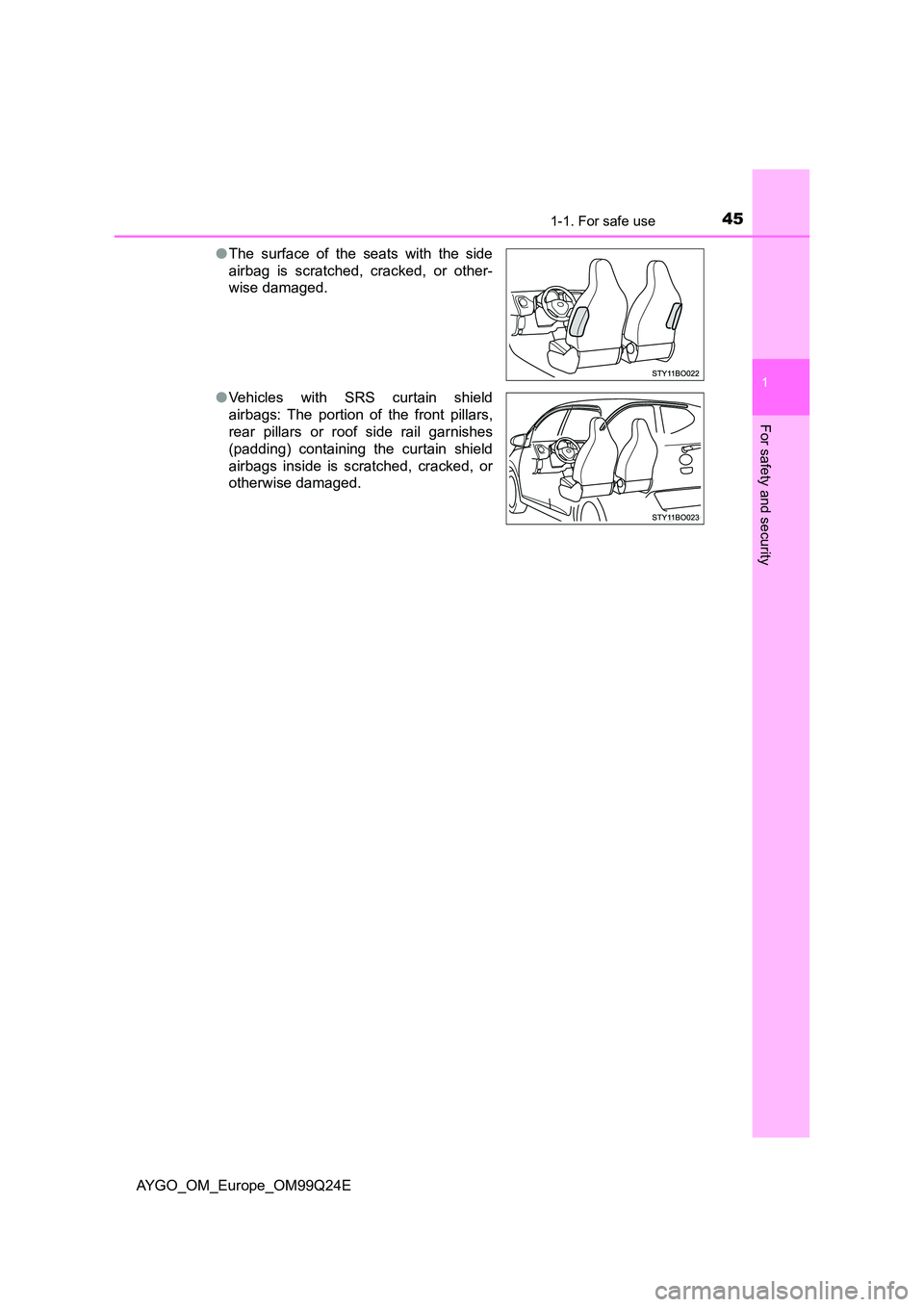
451-1. For safe use
1
For safety and security
AYGO_OM_Europe_OM99Q24E
● The surface of the seats with the side
airbag is scratched, cracked, or other-
wise damaged.
● Vehicles with SRS curtain shield
airbags: The portion of the front pillars,
rear pillars or roof side rail garnishes
(padding) containing the curtain shield
airbags inside is scratched, cracked, or
otherwise damaged.
Page 46 of 480

461-1. For safe use
AYGO_OM_Europe_OM99Q24E
Exhaust gas precautions
Harmful substance to the human body is included in exhaust
gases if inhale.
WARNING
Exhaust gases include harmful carbon monoxide (CO), which is colorless and
odorless. Observe the following precautions.
Failure to do so may cause exhaust gases enter the vehicle and may lead to
an accident caused by light-headedness, or may lead to death or a serious
health hazard.
■ Important points while driving
● Keep the back door closed.
● If you smell exhaust gases in the vehicle even when the back door is
closed, open the windows and have the vehicle inspected at any autho-
rized Toyota dealer or repairer, or another duly qualified and equipped pro-
fessional as soon as possible.
■ When parking
● If the vehicle is in a poorly ventilated area or a closed area, such as a
garage, stop the engine.
● Do not leave the vehicle with the engine running for a long time.
If such a situation cannot be avoided, park the vehicle in an open space
and ensure that exhaust fumes do not enter the vehicle interior.
● Do not leave the engine running in an area with snow build-up, or where it
is snowing. If snowbanks build up around the vehicle while the engine is
running, exhaust gases may collect and enter the vehicle.
■ Exhaust pipe
The exhaust system needs to be checked periodically. If there is a hole or
crack caused by corrosion, damage to a joint or abnormal exhaust noise, be
sure to have the vehicle inspected and repaired by any authorized Toyota
dealer or repairer, or another duly qualified and equipped professional.
Page 47 of 480
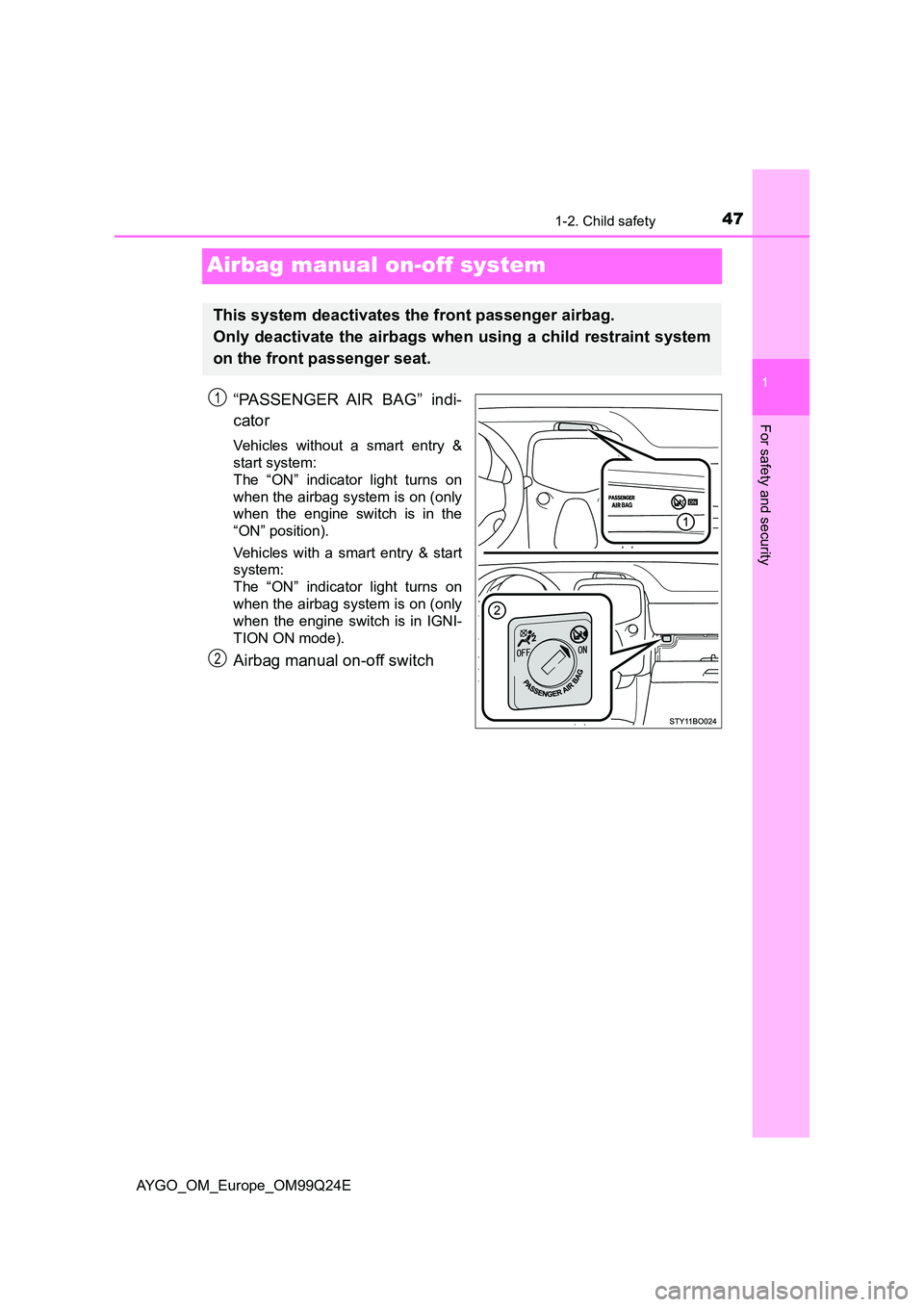
471-2. Child safety
1
For safety and security
AYGO_OM_Europe_OM99Q24E
Airbag manual on-off system
“PASSENGER AIR BAG” indi-
cator
Vehicles without a smart entry &
start system:
The “ON” indicator light turns on
when the airbag system is on (only
when the engine switch is in the
“ON” position).
Vehicles with a smart entry & start
system:
The “ON” indicator light turns on
when the airbag system is on (only
when the engine switch is in IGNI-
TION ON mode).
Airbag manual on-off switch
This system deactivates the front passenger airbag.
Only deactivate the airbags when using a child restraint system
on the front passenger seat.
1
2
Page 48 of 480
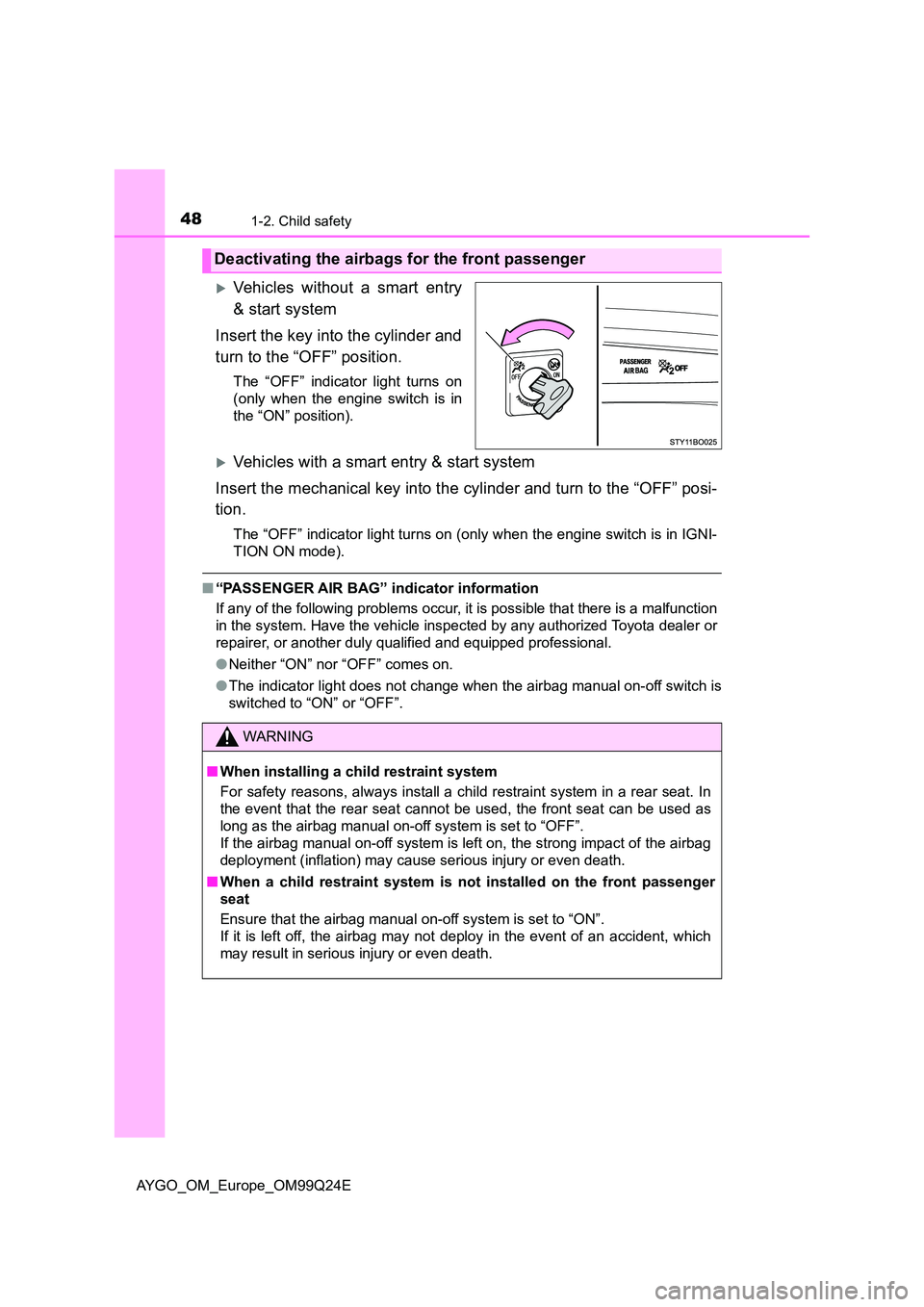
481-2. Child safety
AYGO_OM_Europe_OM99Q24E
Vehicles without a smart entry
& start system
Insert the key into the cylinder and
turn to the “OFF” position.
The “OFF” indicator light turns on
(only when the engine switch is in
the “ON” position).
Vehicles with a smart entry & start system
Insert the mechanical key into the cylinder and turn to the “OFF” posi-
tion.
The “OFF” indicator light turns on (only when the engine switch is in IGNI-
TION ON mode).
■ “PASSENGER AIR BAG” indicator information
If any of the following problems occur, it is possible that there is a malfunction
in the system. Have the vehicle inspected by any authorized Toyota dealer or
repairer, or another duly qualified and equipped professional.
● Neither “ON” nor “OFF” comes on.
● The indicator light does not change when the airbag manual on-off switch is
switched to “ON” or “OFF”.
Deactivating the airbags for the front passenger
WARNING
■ When installing a child restraint system
For safety reasons, always install a child restraint system in a rear seat. In
the event that the rear seat cannot be used, the front seat can be used as
long as the airbag manual on-off system is set to “OFF”.
If the airbag manual on-off system is left on, the strong impact of the airbag
deployment (inflation) may cause serious injury or even death.
■ When a child restraint system is not installed on the front passenger
seat
Ensure that the airbag manual on-off system is set to “ON”.
If it is left off, the airbag may not deploy in the event of an accident, which
may result in serious injury or even death.
Page 49 of 480
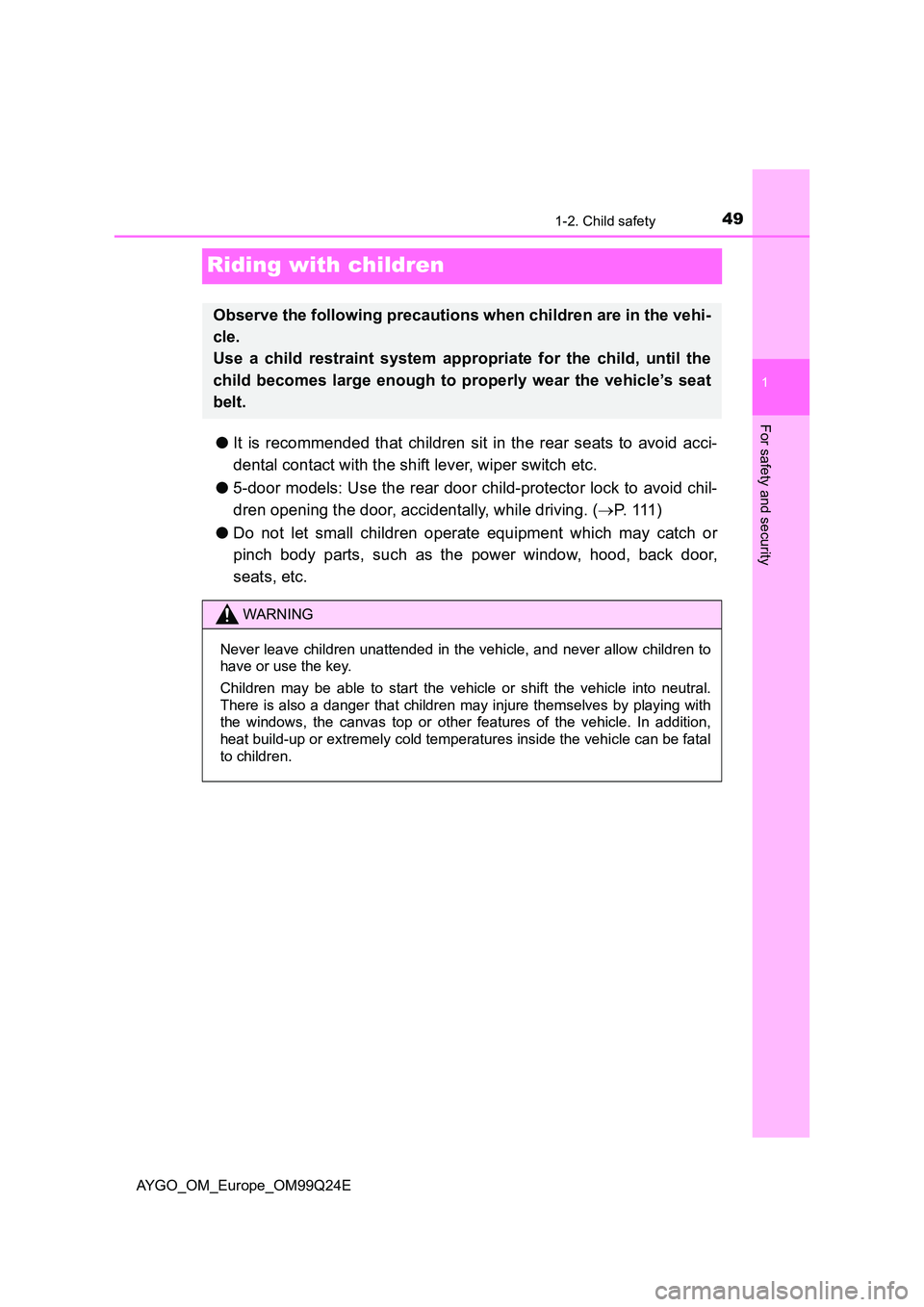
491-2. Child safety
1
For safety and security
AYGO_OM_Europe_OM99Q24E
Riding with children
●It is recommended that children sit in the rear seats to avoid acci-
dental contact with the shift lever, wiper switch etc.
● 5-door models: Use the rear door child-protector lock to avoid chil-
dren opening the door, accidentally, while driving. ( P. 111 )
● Do not let small children operate equipment which may catch or
pinch body parts, such as the power window, hood, back door,
seats, etc.
Observe the following precautions when children are in the vehi-
cle.
Use a child restraint system appropriate for the child, until the
child becomes large enough to properly wear the vehicle’s seat
belt.
WARNING
Never leave children unattended in the vehicle, and never allow children to
have or use the key.
Children may be able to start the vehicle or shift the vehicle into neutral.
There is also a danger that children may injure themselves by playing with
the windows, the canvas top or other features of the vehicle. In addition,
heat build-up or extremely cold temperatures inside the vehicle can be fatal
to children.
Page 50 of 480
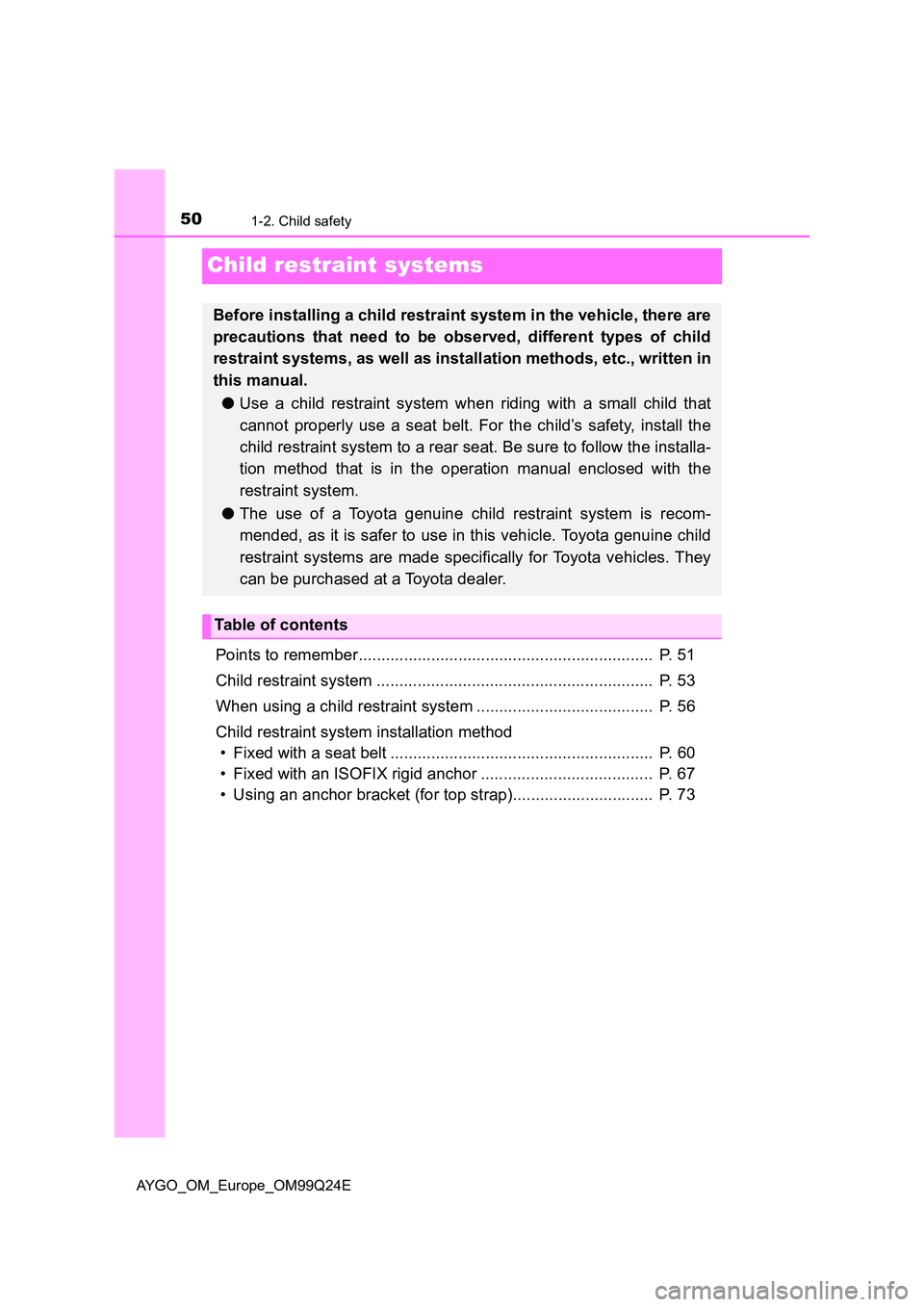
501-2. Child safety
AYGO_OM_Europe_OM99Q24E
Child restraint systems
Points to remember................................................................. P. 51
Child restraint system ............................................................. P. 53
When using a child restraint system ....................................... P. 56
Child restraint system installation method
• Fixed with a seat belt .......................................................... P. 60
• Fixed with an ISOFIX rigid anchor ...................................... P. 67
• Using an anchor bracket (for top strap)............................... P. 73
Before installing a child restraint system in the vehicle, there are
precautions that need to be observed, different types of child
restraint systems, as well as installation methods, etc., written in
this manual.
● Use a child restraint system when riding with a small child that
cannot properly use a seat belt. For the child’s safety, install the
child restraint system to a rear seat. Be sure to follow the installa-
tion method that is in the operation manual enclosed with the
restraint system.
● The use of a Toyota genuine child restraint system is recom-
mended, as it is safer to use in this vehicle. Toyota genuine child
restraint systems are made specifically for Toyota vehicles. They
can be purchased at a Toyota dealer.
Table of contents